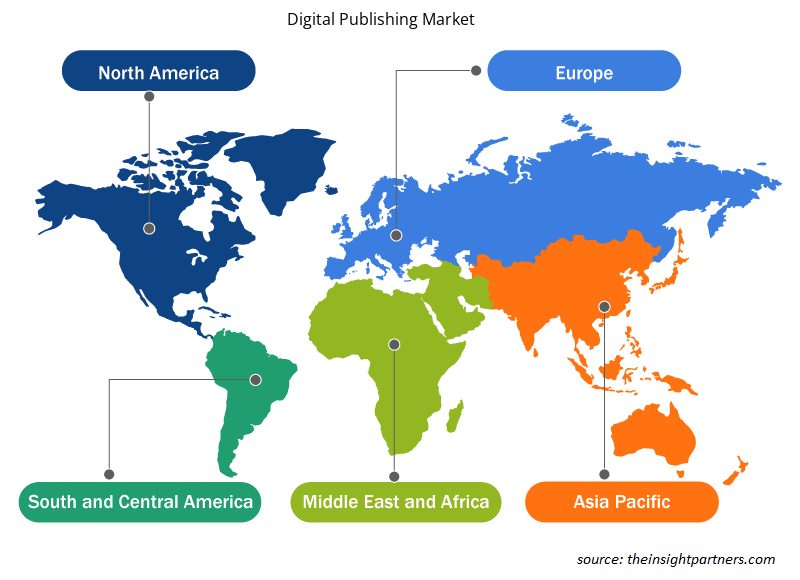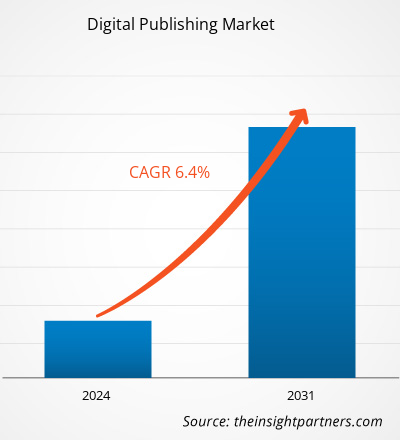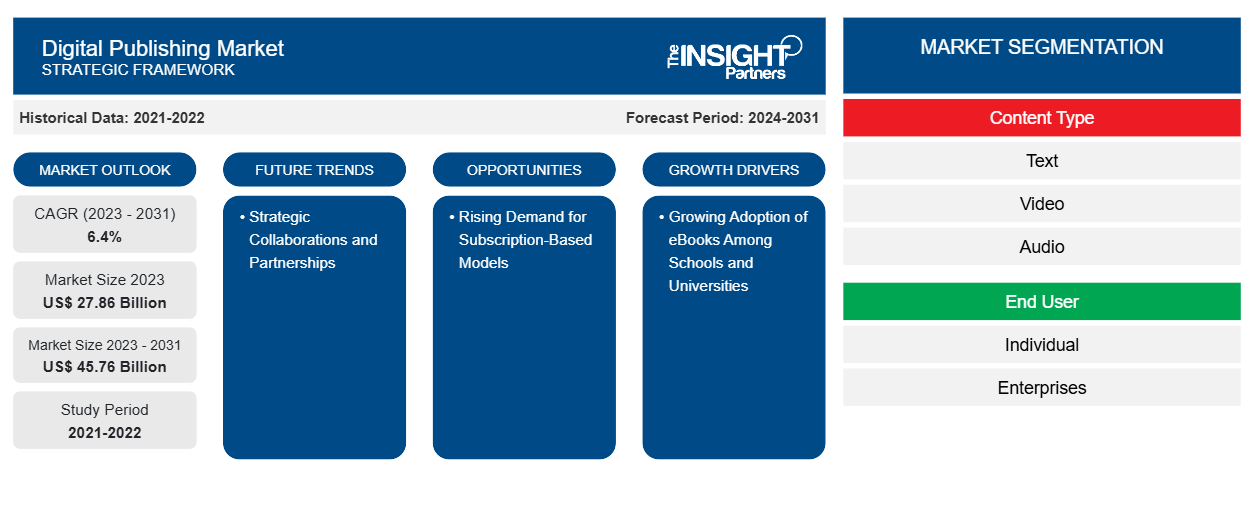Si prevede che la dimensione del mercato dell'editoria digitale raggiungerà i 45,76 miliardi di dollari entro il 2031, rispetto ai 27,86 miliardi di dollari del 2023. Si prevede che il mercato registrerà un CAGR del 6,4% nel periodo 2023-2031. È probabile che le collaborazioni e le partnership strategiche rimangano una tendenza chiave nel mercato.
Analisi del mercato dell'editoria digitale
L'editoria digitale sta rapidamente sostituendo il tradizionale metodo di pubblicazione cartacea. Inoltre, la pandemia di COVID-19 ha anche alimentato l'aumento dei media digitali insieme ad altri fattori che promuovono la crescita dell'editoria digitale. Gli editori stanno rapidamente aumentando la distribuzione ed espandendo i loro attuali flussi di entrate scegliendo l'editoria digitale. Oltre ai fattori sopra menzionati, ci sono diverse nuove funzionalità di editoria digitale che dovrebbero avere un impatto sulla crescita dell'editoria digitale nei prossimi 6-7 anni. Ad esempio, la documentazione e la semplicità di implementazione del prodotto, così come le prestazioni e l'esperienza utente che sono rapide e semplici da accedere, spingono la necessità di contenuti originali o contenuti generati dagli utenti per fidelizzare gli utenti, monetizzare i contenuti e integrare l'e-commerce.
Panoramica del mercato dell'editoria digitale
L'editoria digitale, nota come editoria elettronica o online, comporta la diffusione di vari contenuti online come riviste, magazine, quotidiani ed eBook. Attraverso questo processo, qualsiasi azienda o entità editoriale può convertire documenti e dati cartacei in formato digitale, a cui è possibile accedere online, scaricare, modificare e stampare o condividere a discrezione degli utenti.
Personalizza questo report in base alle tue esigenze
Riceverai la personalizzazione gratuita di qualsiasi report, comprese parti di questo report, o analisi a livello nazionale, pacchetto dati Excel, oltre a usufruire di grandi offerte e sconti per start-up e università
-
Scopri le principali tendenze di mercato in questo rapporto.Questo campione GRATUITO includerà analisi di dati che spaziano dalle tendenze di mercato alle stime e alle previsioni.
Driver e opportunità del mercato dell'editoria digitale
Crescente adozione di eBook tra scuole e università per favorire il mercato
Gli eBook supportano le istituzioni educative nel raggiungimento di tre obiettivi strategici principali: migliorare l'esperienza degli studenti e i risultati accademici in un contesto più competitivo, promuovere l'innovazione nell'insegnamento, nell'apprendimento e nella ricerca e aiutare nell'utilizzo ottimale di spazio e risorse di personale. Per le università e le loro biblioteche, un problema di vecchia data è garantire la tempestiva disponibilità di libri importanti, con la principale lamentela nei sondaggi degli studenti che spesso riguarda il numero inadeguato di copie. Gli studenti possono accedere facilmente agli eBook in qualsiasi momento e da qualsiasi luogo, rendendolo un'opzione conveniente che si allinea alle loro aspettative in modo più efficiente.
Inoltre, il crescente progresso nell'istruzione, nella formazione e nell'esplorazione sta influenzando l'adozione globale dell'editoria digitale. Ad esempio, l'Università di Leicester offre il Master in Sicurezza, Conflitti e Sviluppo Internazionale tramite apprendimento online. Il Dipartimento di Criminologia offre un programma su misura per individui che aspirano a entrare nel settore dello sviluppo internazionale. Gli studenti di questo programma possono lavorare in contesti militari, regioni remote o come peacekeeper, lontano da un tipico ambiente scolastico. Ogni studente riceve un iPad contenente materiali del corso, eBook e un'app del corso per l'accesso. Gli studenti possono accedere e leggere questi eBook anche quando il loro posto di lavoro non dispone di una connessione Internet affidabile, che spesso potrebbe non essere disponibile o non essere affidabile. Il crescente utilizzo di eBook nelle istituzioni educative sta guidando l'espansione del settore dell'editoria digitale mondiale.MSc in Security, Conflict, and International Development through online learning. The Department of Criminology offers a program tailored for individuals in or aspiring to be in the international development sector. Students in this program can work in military settings, remote regions, or as peacekeepers, away from a typical classroom setting. Each student receives an iPad containing course materials, eBooks, and a course app for access. Students can access and read these eBooks even when their workplace lacks a reliable internet connection, which may often be unavailable or unreliable. The increasing use of eBooks in educational institutions is driving the expansion of the worldwide digital publishing industry.
Crescente domanda di modelli basati su abbonamento
L'ambiente online in continua evoluzione richiede flessibilità, spingendo gli editori a diversificare le proprie fonti di reddito. Stanno cercando nuovi modi per garantire stabilità finanziaria, espandendosi oltre i soliti modelli di pubblicità e abbonamento. Questa nuova strategia è vista in diversi modi: attraverso partnership di contenuti sponsorizzati, dove i marchi lavorano insieme su contenuti pertinenti, o marketing di affiliazione, dove gli editori guadagnano soldi commercializzando prodotti o servizi e guadagnando commissioni. Organizzare eventi o creare corsi online fornisce modi diretti per interagire con i lettori. Crea un legame più profondo e la possibilità di maggiori entrate. Gli editori stanno rivalutando i loro metodi attuali, puntando a personalizzare e soddisfare le esigenze dei singoli utenti. I micropagamenti, che stanno diventando sempre più popolari, consentono ai lettori di pagare una piccola quota per singoli articoli anziché impegnarsi in servizi di abbonamento completi, offrendo maggiore flessibilità e soddisfacendo diverse abitudini di consumo.Micropayments, which are becoming increasingly popular, enable readers to pay a small fee for individual articles rather than committing to full subscription services, providing more flexibility and meeting varying consumption habits.
Analisi della segmentazione del rapporto sul mercato dell'editoria digitale
I segmenti chiave che hanno contribuito alla derivazione dell'analisi del mercato dell'editoria digitale sono il tipo di contenuto e l'utente finale.
- In base al tipo di contenuto, il mercato è segmentato in testo, video e audio. Il segmento video ha detenuto una quota di mercato significativa nel 2023.
- In termini di utente finale, il mercato è diviso in individui e aziende. Il segmento individuale deteneva una quota sostanziale del mercato nel 2023.
Analisi della quota di mercato dell'editoria digitale per area geografica
L'ambito geografico del rapporto sul mercato dell'editoria digitale è suddiviso principalmente in cinque regioni: Nord America, Asia Pacifico, Europa, Medio Oriente e Africa, Sud e Centro America.
Si prevede che il Nord America deterrà una quota significativa del mercato dell'editoria digitale nel 2023. L'aumento previsto della domanda per il mercato dell'editoria digitale in questa regione è guidato dalla crescente necessità di pubblicazioni digitali migliorate. I principali leader di mercato come Adobe Inc., Apple Inc., Amazon.com Inc., Alphabet Inc. e altri stanno impegnandosi in partnership, acquisizioni e nello sviluppo di nuovi prodotti e miglioramenti, che stanno guidando la crescita del mercato nella regione. Un esempio è quando Comcast Inc. ha presentato una nuova soluzione a marzo 2021 per connettersi alla gestione centralizzata delle campagne pubblicitarie per la televisione.Amazon.com Inc., Alphabet Inc., and others are engaging in partnerships, acquisitions, and the development of new products and enhancements, which is driving market growth in the region. An example is when Comcast Inc. unveiled a new solution in March 2021 to connect with centralized advertising campaign management for television.
Approfondimenti regionali sul mercato dell'editoria digitale
Le tendenze regionali e i fattori che influenzano il mercato dell'editoria digitale durante il periodo di previsione sono stati ampiamente spiegati dagli analisti di Insight Partners. Questa sezione discute anche i segmenti e la geografia del mercato dell'editoria digitale in Nord America, Europa, Asia Pacifico, Medio Oriente e Africa e America centrale e meridionale.

- Ottieni i dati specifici regionali per il mercato dell'editoria digitale
Ambito del rapporto sul mercato dell'editoria digitale
| Attributo del report | Dettagli |
|---|---|
| Dimensioni del mercato nel 2023 | 27,86 miliardi di dollari USA |
| Dimensioni del mercato entro il 2031 | 45,76 miliardi di dollari USA |
| CAGR globale (2023-2031) | 6,4% |
| Dati storici | 2021-2022 |
| Periodo di previsione | 2024-2031 |
| Segmenti coperti |
Per tipo di contenuto
|
| Regioni e Paesi coperti |
America del Nord
|
| Leader di mercato e profili aziendali chiave |
|
Densità degli attori del mercato dell'editoria digitale: comprendere il suo impatto sulle dinamiche aziendali
Il mercato dell'editoria digitale sta crescendo rapidamente, spinto dalla crescente domanda degli utenti finali dovuta a fattori quali l'evoluzione delle preferenze dei consumatori, i progressi tecnologici e una maggiore consapevolezza dei vantaggi del prodotto. Con l'aumento della domanda, le aziende stanno ampliando le loro offerte, innovando per soddisfare le esigenze dei consumatori e capitalizzando sulle tendenze emergenti, il che alimenta ulteriormente la crescita del mercato.
La densità degli operatori di mercato si riferisce alla distribuzione di aziende o società che operano in un particolare mercato o settore. Indica quanti concorrenti (operatori di mercato) sono presenti in un dato spazio di mercato in relazione alle sue dimensioni o al valore di mercato totale.
Le principali aziende che operano nel mercato dell'editoria digitale sono:
- HurixDigitale
- Viuzza
- Tecnologie VitalSource
- Tecnologie Excelsoft
- Società anonima
- Istruzione
Disclaimer : le aziende elencate sopra non sono classificate secondo un ordine particolare.

- Ottieni una panoramica dei principali attori del mercato dell'editoria digitale
Notizie e sviluppi recenti del mercato dell'editoria digitale
Il mercato dell'editoria digitale viene valutato raccogliendo dati qualitativi e quantitativi dopo la ricerca primaria e secondaria, che include importanti pubblicazioni aziendali, dati associativi e database. Di seguito sono elencati alcuni degli sviluppi nel mercato dell'editoria digitale:
- FlipHTML5 presenta il suo innovativo creatore di ebook AI, che rivoluziona il settore dell'editoria digitale. Questo strumento avanzato semplifica la creazione di ebook, consentendo agli utenti di produrre ebook professionali e interattivi senza problemi.
(Fonte: PR UNDERGROUND, Comunicato stampa, giugno 2024)
- In una mossa coraggiosa per dare ulteriore potere agli editori e ai creatori digitali, Ezoic ha appena lanciato il suo attesissimo programma Enterprise. Progettato esplicitamente per i creatori su scala aziendale, questa suite completa di servizi e funzionalità rappresenta un'espansione significativa delle offerte di Ezoic, fornendo soluzioni su misura per soddisfare le esigenze uniche degli editori digitali e dei creatori di video su larga scala.
(Fonte: Ezoic, sito web aziendale, marzo 2023)
Copertura e risultati del rapporto sul mercato dell'editoria digitale
Il rapporto “Dimensioni e previsioni del mercato dell’editoria digitale (2021-2031)” fornisce un’analisi dettagliata del mercato che copre le seguenti aree:
- Dimensioni e previsioni del mercato dell'editoria digitale a livello globale, regionale e nazionale per tutti i segmenti di mercato chiave coperti dall'ambito
- Tendenze del mercato dell'editoria digitale e dinamiche di mercato come driver, vincoli e opportunità chiave
- Analisi dettagliata delle cinque forze PEST/Porter e SWOT
- Analisi del mercato dell'editoria digitale che copre le principali tendenze del mercato, il quadro globale e regionale, i principali attori, le normative e i recenti sviluppi del mercato
- Analisi del panorama industriale e della concorrenza che copre la concentrazione del mercato, l'analisi della mappa di calore, i principali attori e gli sviluppi recenti per il mercato dell'editoria digitale
- Profili aziendali dettagliati
- Analisi storica (2 anni), anno base, previsione (7 anni) con CAGR
- Analisi PEST e SWOT
- Valore/volume delle dimensioni del mercato - Globale, Regionale, Nazionale
- Industria e panorama competitivo
- Set di dati Excel
Report recenti
Rapporti correlati
Testimonianze
Motivo dell'acquisto
- Processo decisionale informato
- Comprensione delle dinamiche di mercato
- Analisi competitiva
- Analisi dei clienti
- Previsioni di mercato
- Mitigazione del rischio
- Pianificazione strategica
- Giustificazione degli investimenti
- Identificazione dei mercati emergenti
- Miglioramento delle strategie di marketing
- Aumento dell'efficienza operativa
- Allineamento alle tendenze normative























 Ottieni un campione gratuito per - Mercato dell'editoria digitale
Ottieni un campione gratuito per - Mercato dell'editoria digitale